As bright as butterflies
Moths are often dismissed as brown and dull, but many species are actually bright and colourful. There are burnet moths with black and red wings, tiger moths with beautiful bold patterns, and hawk-moths that can be as large as your hand. Even the moths that are brown have intricate patterns and incredible camouflage. With around 2,500 species of moth in the UK, there's an amazing amount of diversity to be discovered!
Which moths am I likely to see?
Moths don't just come out at night. Some species fly during the day, especially on warm and sunny days. Others can be easily disturbed from their resting spot on vegetation, flying a short distance before settling down again. With sharp eyes or a bit of luck, you can even spy the more nocturnal species resting on bushes, trees, walls, or fences - especially if there's a light source close by.

Day-flying moths
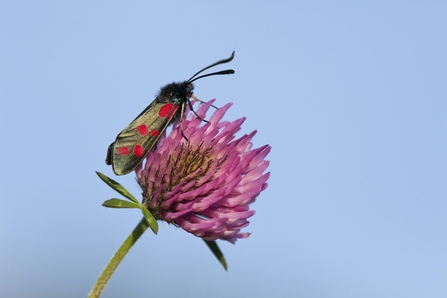
©Guy Edwardes/2020VISION
Six-spot burnet
Description: Black with slender wings. Each forewing has six red spots (the two closest to the head often look like one red smudge). Flies in the day, visiting flowers like a butterfly.
When & where: June-August. Flowery grassland throughout the UK. Caterpillars feed on bird's-foot trefoil.

©Bob Coyle
Cinnabar
Description: Each black forewing has a red line and two red dots, and the hindwings are bright red. Flies in sunshine and is attracted to light at night.
When & where: May-August. A variety of habitats, including sand dunes, heathlands and gardens. Caterpillars feed on ragwort.
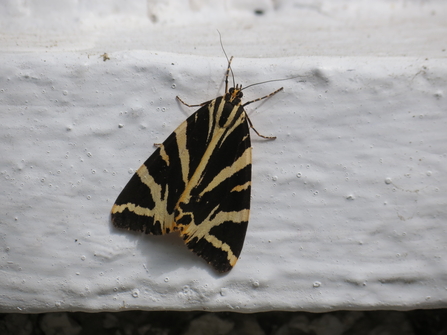
Catherine Williamson/cnaturephotography.com
Jersey tiger
Description: The black forewings have striking creamy-white stripes and the hindwings are bright red, yellow or orange. Flies on warm days.
When & where: July-September. A range of habitats including rough ground, coastal cliffs and gardens. On the south coast of England, but rapidly spreading north, with a strong London population.
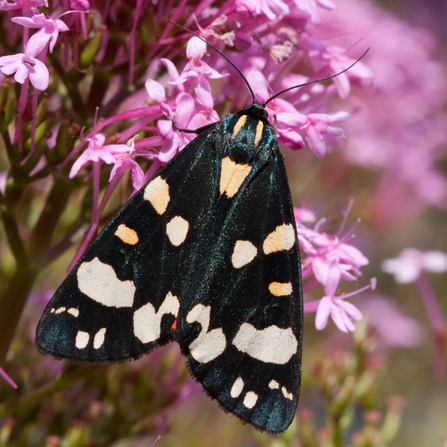
Scarlet tiger ©Vaughn Matthews
Scarlet tiger
Description: Has iridescent black forewings with white and yellow spots, and red hingwings with black markings. Flies during the day.
When & where: June-July. Favours damp habitats like riverbanks and fens, but sometimes visits gardens. Most common in the south-west of England and Wales.

©Derek Moore
Hummingbird hawk-moth
Description: The forewings and chunky body are grey-brown, with orange hindwings. Flits from flower to flower, hovering to feed like a hummingbird.
When & where: Mostly April-September, but can be seen in other months. An immigrant from southern Europe and north Africa. Most common on south coast but can turn up almost anywhere.
Silver Y ©Bruce Shortland
Silver y
Description: Brown with a metallic silver y-shaped mark on each forewing. One of the most commonly seen day-flying moths, easily disturbed from vegetation and often seen flying frantically as it feeds on flowers.
When & where: Mostly May-September, but can be seen in other months. An immigrant that is sometimes found in large numbers on the coast, but can be seen almost anywhere, including gardens.
Burnet companion ©Tom Hibbert
Burnet companion
Description: A brownish moth with wavy crosslines on the forewings and orange-yellow on the hindwings. Flies on warm days, often with other species of moth and dingy skipper butterflies.
When & where: May-July. Common and widespread in southern England, rare in Scotland and local elsewhere in the UK. Found on flowery grasslands, including meadows, verges and woodland rides.
Night-flying moths

Swallow-tailed moth ©Vaughn Matthews
Swallow-tailed moth
Description: An elegant pale yellow moth, easily identified by the pointed tail on each hindwing. Flies from dusk and is attracted to light.
When & where: June-August. Sometimes second generation September-October. Widespread in most of UK. Found in a variety of habitats including parks and gardens.

Brimstone moth ©Amy Lewis
Brimstone moth
Description: A bright yellow moth with a chestnut line along the leading edge of each forewing, a mark at the tip, and a brown-edged white dash. Sometimes disturbed from vegetation in the day, flies just before dusk and comes to light at night.
When & where: April-October. Common across most of the UK. In woodland, scrub, hedgerows and gardens.
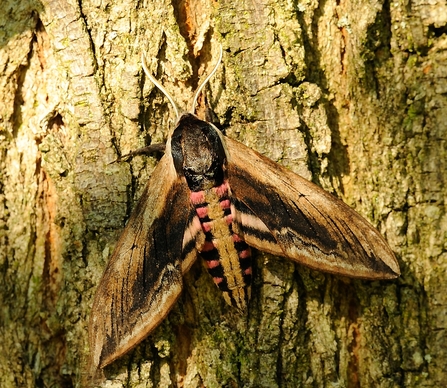
©Amy Lewis
Privet hawk-moth
Description: A large moth (wingspan up to 12cm), with a blackish thorax and pink and black banded abdomen. Forewings are brown and hindwings are pink and black. Feeds on flowers at night and comes to light.
When & where: June-July. Common in southern England and south-west Wales, more scattered further north. A variety of habitats including gardens and hedgerows.

Herald ©Amy Lewis
Herald
Description: Brown with white crosslines, orange blotches and scalloped wings. Adults hibernate over winter and are sometimes found in outbuildings or caves.
When & where: August-November and March-June after hibernation. Throughout the UK, in woodland, parks, gardens and other places the foodplants (willows and poplars) are found.
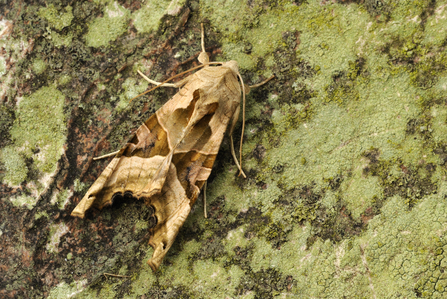
©Amy Lewis
Angle shades
Description: A distinctive moth that rests with its wings creased. Olive green with pink-brown arrow-shaped markings. Often seen resting on vegetation, walls and fences in the day.
When & where: Mainly May-October. Throughout the UK, in most habitats including parks and gardens.

Green carpet ©Amy Lewis
Green carpet
Description: A broad-winged, green moth with dark blotches and wavy, white lines across the wings. Flies at dusk and is easily disturbed from vegetation during the day.
When & where: May-September. Common across the UK, in most habitats including parks and gardens.
Large yellow underwing © Emma Lusby
Large yellow underwing
Description: A large, variable moth. The long, rounded forewing has a distinctive black mark on the leading edge, near the tip. The hindwings are bright yellow with a black band. Often comes to light.
When & where: June-October. Found almost anywhere, but most commonly in open grassy areas.

